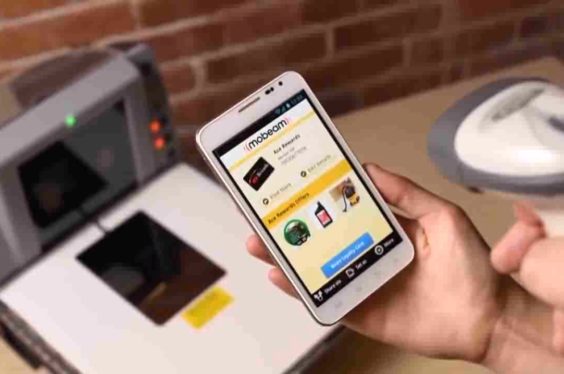There are paper coupons, and then there are digital coupons. But how do you turn paper coupons into digital coupons? Some have suggested simply photographing your paper coupons, while others prefer transferring coupons’ bar codes to your mobile phone screen.
But there are plenty of problems with each of those approaches. So one company is proposing a new way – sending your grocery coupons straight to your phone, and making them invisible.
How do you redeem coupons you can’t even see? And isn’t creating a whole new platform to digitize good old-fashioned paper coupons, a complicated solution to a not-particularly-pressing problem?
The mobile technology company Mobeam doesn’t believe so. Mobeam has announced the availability of a new mobile couponing concept, declaring the news to be of “landmark significance.”
“The paper coupon is one of the last archaic components of an industry that has digitally evolved in almost every other way,” Mobeam CEO George Garrick said. “Mobile manufacturer coupons are secure and fraud resistant, and the antiquated process of shipping coupons out of the country to be manually counted and cleared can be replaced with fast, accurate, secure digital processing.”
The couponing platform utilizes technology that Mobeam developed several years ago. But it can only now be put to practical use for manufacturers, thanks to a tweak in the bar coding system. A special category of bar codes has been created for mobile devices, which will allow store scanners to differentiate between paper and paperless coupons.
Now, Mobeam is able to fully deploy its technology, which solves a problem that you may not have known existed – most retail scanners can’t read bar codes displayed on a phone. The red laser scanners can decipher bar codes on a plain piece of paper, but not on a backlit, reflective mobile phone screen.
So Mobeam created new technology, currently embedded into millions of Samsung phones, that basically reverses the scanning process. Your Mobeam-enabled phone can translate the bar code into beams of light, then send those beams to the scanner so it can “read” the bar code.
Some stores, like Target, have camera-based scanners that are able to read bar codes on your phone without Mobeam’s technology. But those retailers typically accept only their own store coupons. So far, no one has offered manufacturer’s coupons in true mobile form.
That’s partly because manufacturers don’t want their bar codes displayed on a mobile screen. What’s to stop you from grabbing a screen capture of the bar code, saving it, sharing it, and using it over and over again?
So Mobeam realized, since the scanner isn’t reading the image of the bar code on your screen anyway, there’s no need to show the bar code on your screen at all. So it doesn’t. It just turns the bar code into beams of light without actually displaying it on the screen, so now you can use your phone to redeem coupons that are essentially invisible.
Well, you can, as soon as retailers and manufacturers start adopting the technology, allowing these invisible coupons to become reality.
“We’re now in the process of working with brands to provide digital coupons, and with retailers to make slight modifications to their points of sale,” Garrick told Coupons in the News. “As retailers begin to adopt it, manufacturers will be able to issue coupons in digital form.”
As Mobeam envisions it, you’ll be able to load its coupons to a mobile wallet, from anywhere that you currently look for coupons online. “You’d go to any third-party site that has coupons, and now you’ll start to see a choice: load to mobile wallet,” Garrick explained.
Once you open a mobile wallet, such as the Mobeam-enabled Samsung Pay, the coupons will appear in your account. Then, after the cashier rings up your order, you hold your phone over the scanner, and scan your first coupon. And then you call up the next one, and scan it. And then the next one, and the next one.
That’s one of the drawbacks of the concept – each coupon has to be scanned individually. They’re not combined into a single bar code. If you think people behind you are impatient when you hand your cashier a stack of paper coupons, imagine how they – and your cashier – will feel as they watch you repeatedly wave your phone over the scanner, pausing each time to swipe your screen and call up the next coupon.
Garrick said they’re considering ways to speed up the process, such as cycling through the coupons automatically. But each bar code will still have to be scanned individually, in order for the coupons to be processed correctly.
It may sound like a lot of work, especially when there are already digital coupons without bar codes, that you don’t have to physically scan at all. Plenty of retailers these days have digital coupons that you can redeem all at once, just by swiping a loyalty card or typing in your phone number. But some don’t – including big retailers like Walmart, and a lot of smaller independent stores.
Plus, most digital coupon platforms are retailer-based. You sign up with the store, and the retailer gets all the customer data about the coupons you use and products you buy. Mobeam says its coupons will be manufacturer-centric – allowing the coupon issuers to engage directly with you instead of through a middle-man retailer.
There are opportunities and challenges, to be sure. But the biggest challenge at the moment, is turning this coupon technology into actual coupons. Mobeam has partnered with manufacturers such as Procter & Gamble and General Mills. But so far, no manufacturer has come up with concrete plans to offer coupons via this new method.
As with any new technology, the key is to get everyone on board with it. Mobeam is working to gets its beaming technology installed in more phones, and its coupons embedded in more mobile wallets, while encouraging stores to make the necessary tweaks to their scanners. And only then might manufacturers begin to offer scannable mobile coupons that you can actually use.
Plenty of people have predicted the demise of paper coupons, and the technology exists to make it happen. But it will only happen if retailers, manufacturers and shoppers embrace it. Ultimately, it’s the difference between a great idea that revolutionizes couponing – and a great idea that remains just an idea.
Image source: Mobeam















It’s too bad more folks can’t appreciate just how killer the actual IP behind Mobeam is (and has always been).
No one vendor or single entity can make retailers cooperate long enough to make mobile barcode industry standards, which is too bad because:
“pulsating light emissions from your keyboard backlight” is a relatively low-tech solution that completely pantses the much fancier (and much faultier) image-capture routines to which most mobile barcode platforms (like QR) are currently tethered.